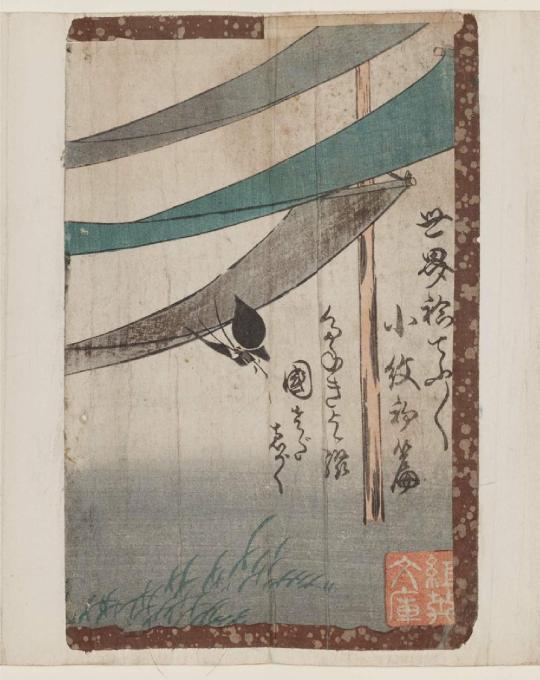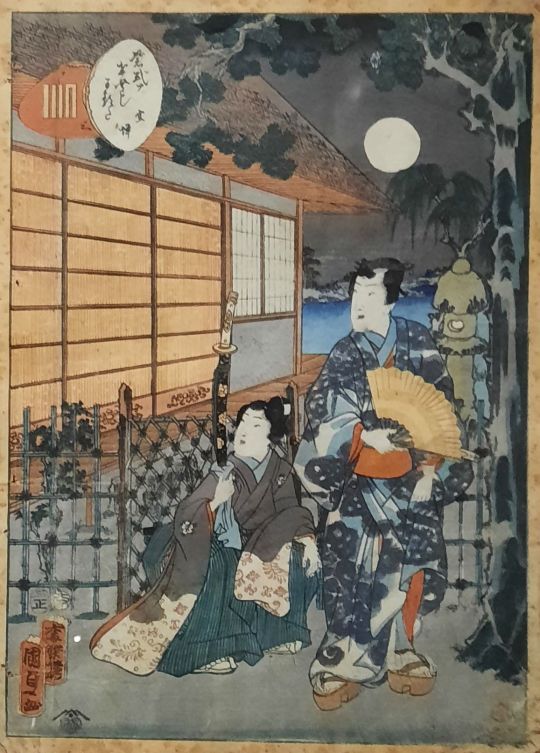#Utagawa Kunisada II
Explore tagged Tumblr posts
Text
More for #ILoveHorsesDay ❤️🐴:


Horses, a New Publication (Shimpan uma zukushi)
Color woodblock prints
c.1847-8 by Utagawa Hiroshige II (Japan, 1826–1869), 377x257mm
1874 by Utagawa Kunisada III (Japan, 1848–1920), 337x225mm
Legion of Honor Museum 1963.30.1472, 1963.30.5519
#animals in art#animal holiday#19th century art#Legion of Honor Museum#Japanese art#East Asian art#Asian art#horse#horses#I Love Horses Day#domesticated animals#print#woodblock print#Utagawa Hiroshige II#Utagawa Kunisada II#ukiyoe
75 notes
·
View notes
Text


Actors Bandô Shûka and Sawamura Tanosuke in the role of Hanaregoma Chôkichi by Utagawa Kunisada and Utagawa Kunisada II respectively.
#utagawa kunisada#utagawa kunisada ii#futatsu chocho kurawa nikki#hanaregoma chokichi#bando shuka#sawamura tanosuke#ukiyo-e#nishiki-e
10 notes
·
View notes
Text
Estampe japonaise sur papier crêpe (Musée du Luxembourg, Paris)

Genji moderne. Visite du jardin
Ces estampes tirées sur papier crêpe étaient collectionnées par Léon Monet qui était amateur d'art japonais comme son frère Claude. Au Japon, ces papiers imprimés servaient aux emballages.
Oeuvre de Utagawa Kunisada II
Gravure sur bois, tirage sur papier crêpe
Éditeur : Isetatsu
Collection particulière
Ancienne collection Léon Monet
3 notes
·
View notes
Text
i still can't believe that my brain's capable of comprehending and building so many complicated concepts and yet my latest idea of ATLA fanfic plot is a fucking EPIC DRAGON FIGHT.
i watched Avatar for the first time when I was like. Eight. Somehow certain things in the show continue to cause the exact same enthusiasm as if my age is Still Eight.
Here I am. It doesn't matter if I can identify the age and general wellbeing of a bird by a single flight feather. It doesn't matter what can I say about habitus of an animal on a clinical examination.
It doesn't matter, because yes but WHAT IF Azula purposely curses herself to be DRAGON AT DAYLIGHT but the curse affects her brother too?! What then?!
I can already see Sokka going "Well, no biggie, if you're human only while the sun is sat, why don't you relocate to the Poles? We have polar nights like, for half of the year! And! When the night is over on one pole, you can just fly to another, so you would See No Sun Ever! ...Alright, I'll admit, in my head the idea sounded a lot better."

i'm ashamed. i feel eight years old. i wanna a dragon story anyway.
#atla#fire hazard siblings#that's not even opening the can of worms about literal Dragon of the West Iroh that I thought about earlier#the picture: Kunisada II Utagawa#The print depicts the Buddha riding on the back of a giant sea-dragon#From the series Modern Illustrations of Buddhist Precepts (Hasso-ki Imayo Utsushi-e)
13 notes
·
View notes
Text

Tenjiku Tokubei riding a giant toad.
Amazing Vintage Illustrations Of Japanese Anthropomorphic Frogs and Toads
The Japanese term “kimo-kawaii” means “cute and ugly,” often describing anthropomorphic frogs and toads in art.
Tenjiku Tokubei (1612-1692) inspired kabuki and literature, portraying him as a spell-caster transforming stones into giant toads. This influenced Kanwatei Onitake, creating Jiraiya, a ninja conjuring phantom frogs. Jiraiya starred in the folk tale Katakiuchi Kidan Jiraiya Monogatari, adapted into kabuki and various media. Matsumoto Hoji, a 19th-century artist, created notable frog woodblocks.

Actor Onoe Tamizô II as Tenjiku Tokubei Artist Utagawa Kunisada I (Toyokuni III) (Japanese, 1786–1864), Publisher Kawaguchiya Uhei (Fukusendô) (Japanese) 1841 (Tenpô 12), 7th month.

Actor Onoe Eizaburo I as a Magician with a Giant Toad Woodblock print.

Sumō wrestling toads by Ohara Hōson 1930.
#vintage illustrations#japanese anthropomorphic frogs and toads#kimo-kawaii#cute and ugly#tenjiku tokubei#kabuki#literature#artist#japanese history#japanese art#woodblock print#ohara hoson
26 notes
·
View notes
Photo



Actors Onoe Kikujirô II as Konoshitagawa Kôsuke (R) and Ôtani Tomomatsu I as Hanyûya Sukeshirô (L), by Utagawa Kunisada I (Toyokuni III)
251 notes
·
View notes
Text

Utagawa Kunisada II (1823–1880)
Hell Courtesan (Jigoku Dayu)
3 notes
·
View notes
Text

Título: La belleza crepuscular (Capítulo 4), de la serie Naipes de Genji de Murasaki Shikibu
1857
Artista: Utagawa Kunisada II (Japón, 1823 – 1880)
Detalles
Otro título: Capítulo 4 Rostros vespertinos
Lugar donde se realizó la obra: Japón
Período: Período Edo (Tokugawa) 1615 - 1868 → Japón
Fecha: 1857
Categoría de medios: Imprimir
Materiales usados: grabado en madera; tinta y color sobre papel
Dimensiones: imagen de 32,9 x 23,2 cm; hoja de 33,5 x 23,4 cm
Fecha de firma: Firmado ll, en japonés, tinta negra "[Baichôrô Kunisada ga]".Sin fecha.
Crédito: Donación de GF Williams 1995
Información e imagen de la web de la Art Gallery NSW.
1 note
·
View note
Photo
sundayjump:
”投扇興当姿絵 しらゐや 五郎 光義 牛若伝次”
二代歌川国貞
”Jiraiya, Goro, Mitsuyoshi and Ushiwaka Denji,
Hair styles of actor for Fan-throwing game”
by Kunisada II Utagawa
Found here

484 notes
·
View notes
Text

Utagawa Kunisada, Portrait of Iwai Kumesaburō II, 1827-1829 x
0 notes
Text
"Trois femmes décorant des raquettes de jeu" d'Utagawa Kunisada II (Maison de la culture du Japon, Paris)

Trois femmes décorant des raquettes / Splendeur des quatre ordres sociaux
Les trois femmes fabriquent, décorent et peignent des raquettes de jeu de volant pour le nouvel an.
Un chat semble écouter leur conversation.
Oeuvre d'Utagawa Kunisada II (1823 - 1880)
fr.wikipedia.org/wiki/Utagawa_Kunisada_II
Vers 1847-1852 (Kyôka - Kaei)
Estampe
2 notes
·
View notes
Text

The Dragon (from the series Modern Illustrations of Buddhist Precepts), Kunisada II, 1860
#art#art history#Asian art#Japan#Japanese art#East Asia#East Asian art#ukiyo-e#woodblock print#Kunisada II#Utagawa Kunisada II#Utagawa School#Buddhism#Buddhist art#Edo period#19th century art
351 notes
·
View notes
Photo

Utagawa Kunisada II (歌川国定) — The Nun Cat (the actor Segawa Kikunojo V) [woodblock print, 1852]
67 notes
·
View notes
Text

Actor Nakamura Shikan II, from Kamigata, formerly Tsurusuke, as Satô Tsuginobu, by Utagawa Kunisada I (Toyokuni III), 1827. Japan
178 notes
·
View notes
Photo



Wrappers for the book ‘Sekai mo awase chôchô komon’ (parts 1-3) by Utagawa Kunisada II (Japanese, 1823–1880).
Published 1859 by Tsutaya Kichizô.
Woodblock prints.
22 notes
·
View notes
